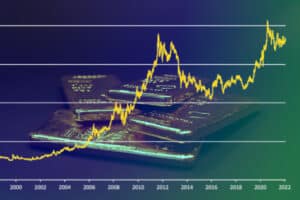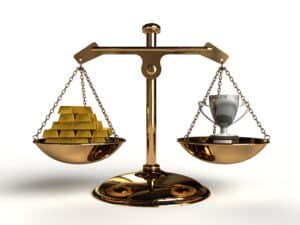One of the most significant economic shifts in the past century has been the move from a gold-backed currency to fiat money. This switch has dramatically altered how governments and individuals view and spend money, creating institutions like the Federal Reserve System to prevent inflation and stabilize the economy.
But while almost all countries have adopted fiat currency, some proponents still argue that the gold standard has numerous advantages, particularly in unstable economic times. Understanding the benefits and drawbacks of gold standard vs. fiat money is essential to making informed investment decisions based on current market activity.
What Is the Gold Standard?
The gold standard links the value of a currency to a physical commodity—gold—creating an international standard that allows countries to trade with each other. Each country sets its price of gold and then buys and sells gold at that price, which influences the value of each country’s currency. For instance, if a country sets the gold price at $200 per ounce, each dollar of that country’s currency would be worth 1/200th of an ounce.
In practical terms, the gold standard meant that people living under the system could exchange their money for gold at any time and vice versa. As the value of gold remained the same or changed very slowly, buying gold was a stable and reliable investment and a common way of concentrating and keeping wealth. A stable medium of exchange made international trade easier between various nations.
The main appeal of the gold standard is that it keeps a currency’s value stable. However, as evidenced by historical events, a stable currency doesn’t always translate to a stable economy, so most countries moved away from the gold standard to today’s fiat currency system.
Gold Throughout History
The history of gold traces back to the first instances of trade. Gold was unique because it didn’t have a practical use and was used as a decorative metal. Unlike copper, bronze, and iron, gold was too soft to use in tools or weapons; its only value was in its appearance and scarcity, making it the perfect trading option for individuals and various populations. Other alternatives in areas without a supply of gold included pearls and ivory, though gold eventually dominated the global market.
Eventually, people started melting gold and other precious metals into coins of set weights, making it easier to determine value. Instead of having to measure out a half ounce of gold powder, you’d simply provide a gold coin that you (and your trading partner) knew weighed half an ounce.
This system wasn’t perfect and led to clipping, where people would shave tiny amounts off coins, eventually gathering enough scrapings to melt into new coins. While several countries introduced new minting technologies to combat the problem, it remained a concern wherever people used gold as currency.
While paper money first became popular in the West in the 16th century, gold continued to dominate Western trade well into the 19th century. The friction between these two trade mediums would eventually form the basis of the gold standard, which attempted to reconcile the two.
Introduction of the Gold Standard
The gold standard in the U.S. underwent several changes in its lifespan, mainly due to changing global and local economic conditions.
Silver’s Role in the Gold Standard
The first iteration of the U.S. gold standard came directly after the War of Independence in the late 1700s. At this time, most of the coins in the U.S. were foreign. Congress wanted a formalized U.S. currency and tied the newly founded dollar’s value to gold and silver.
The Coinage Act of 1792 established the U.S. Mint that started producing gold and silver coins in various denominations. Since silver was much more common than gold, the U.S. adopted a bimetallic standard that tied silver and gold coins to the parity ratio of 15:1 — an accurate reflection of the markets at the time.
Unfortunately, silver declined in value after the initial valuation to a ratio of 15.5:1, leading to an influx of silver coins and a decrease in gold in circulation. Most people used gold for international trade while retaining the lower-value silver coins for domestic use. This shift from gold effectively created a “silver standard” where U.S. currency was tied more closely to silver than gold.
The Coinage Act of 1834 attempted to reverse this situation by instating a 16:1 ratio and reducing the amount of gold in gold coins. This change led to an export of silver and an influx of gold into domestic markets. The Australian and Californian gold rushes further flooded the market with gold, which drove out silver completely, turning the U.S. into a gold-backed currency.
Advantages and Disadvantages of the Gold Standard
No monetary system is perfect, including the gold standard. While it offers several unique advantages, it also has several disadvantages that can result in near-catastrophic economic consequences. In many cases, these advantages and disadvantages only come to light under particular circumstances, which prompts the shift to or from a particular monetary system.
Understanding the pros and cons of the gold standard and how they interact with global trends can help explain why so many countries have abandoned the gold standard in favor of fiat currency.
Advantages
The biggest advantage of the gold standard is that it keeps currency values stable as long as the global gold supply remains constant. It also helps control government spending by making it challenging to mint additional money at will. Since governments can only mint money if it has a corresponding amount of gold in reserve, the gold standard prevents governments from pumping a large influx of currency into the economy that would drive hyperinflation.
Another benefit of the gold standard is that it can stabilize global trade fluctuations. Under a fiat monetary system, exchange rates between currencies can fluctuate rapidly, sometimes even changing the value of trade goods while in transit. If the world operated on a gold standard, exchange rates would stop becoming a potential trading barrier.
Disadvantages
While gold reserves tend to be relatively stable, they are susceptible to fluctuations that affect price stability. For instance, gold rushes can create massive inflation and price variability, leading to economic instability.
Similarly, economic growth can outstrip gold availability, causing periodic deflations and limiting growth in developing and developed nations. Currently, the global gold supply increases approximately 2% per year, while economic growth sits at around 6.5%. Historically, maintaining a gold standard led to 12 years of U.S. deflation and may have impeded economic stabilization after the Great Depression.
The Downfall of the Gold Standard
The global conditions that made the gold standard so effective began to shift in the early 20th century. Unrest, changing political alliances, and the outbreak of World War I drove governments to switch to other monetary policies, showing the world that the gold standard wasn’t as resilient or stable as expected.
This decrease in confidence in the gold standard led to bank rushes and financial panics, which further destabilized economies and caused recessions across the globe. Many smaller countries started stockpiling U.S. dollars and British Pound sterling as reserve currencies, which led to the accumulation of gold reserves in the hands of a few large nations.
President Franklin. D. Roosevelt began the shift away from the gold standard in 1933 by banning private citizens from owning gold. Gold owners could turn their bullion into the government for paper money; the only legal use for gold was for international trade between the U.S. and foreign governments.
The U.S. government proceeded to revalue gold from $20.67 to $35 per ounce, which led to many investors divesting their gold in favor of the U.S. dollar. Since countries could get more from their gold than before, many sold their existing gold holdings, allowing the U.S. to corner the market on gold while simultaneously making the U.S. dollar a global reserve currency.
Western leaders met as World War II ended to formulate the Bretton-Woods Agreement, which became the global monetary framework for the next 30 years. This agreement stated that all other currencies would be valued according to the U.S. dollar and backed by gold at $35 per ounce. This agreement didn’t outright abandon the global gold standard but left the U.S. as the only country still backing its currency on gold.
Introduction of Fiat Money
Various external and internal pressures eventually resulted in the U.S. moving away from the gold standard and to a fiat currency model in 1971.
After the downfall of the gold standard, nations needed a new way to secure the value of their currency. As many countries had already tied their currencies’ value to the U.S. dollar, the switch to complete fiat currency wasn’t a big jump and led to the fiat monetary system that countries use today.
What Is Fiat Money?
Fiat money relies on a governmental decree to determine its value. Since fiat money doesn’t have backing from physical commodities (like gold), it’s intrinsically valueless and only obtains its value through global consensus. Fiat currency examples include the U.S. Dollar, European Euro, and British Pound.
In general, fiat money valuations take into consideration a country’s:
- Economic stability
- Current economic performance
- Political stability
- Investment potential
External factors, such as geopolitics, global pandemics, global inflation, and overall investor appetite for risk can also play a significant role in valuing a country’s currency.
Politically unstable countries experience a weakened currency against the dollar. This makes international trade difficult, leading to inflated commodity prices and further economic hardship.
History of Fiat Money
The first recorded example of fiat money was from China. Paper money first appeared during the 7th century and became the de-facto government-issued currency starting in the 12th century. In most cases, this paper money wasn’t convertible to gold or other precious commodities.
Fiat Money in the U.S.
While fiat currency is a relatively recent form of U.S. currency, the United States has used paper money since the late 18th century. Many people didn’t want to carry around large amounts of gold or silver, and bank issue notes became popular as an alternative. Holders could redeem these bank issue notes for a set amount of silver or gold at the newly established Bank of America.
However, many private banks started issuing their own notes, making it impossible to create a universal paper currency. Many banks were issuing more notes than they had reserves, and counterfeit notes were common.
While the system was already faltering, the advent of the Civil War pushed the government to act. Congress issued the first “greenbacks” in 1861. Initially, these greenback currency notes were limited and not exchangeable for gold, leading to devaluation and low uptake. In 1878, Congress changed the ruling and made the greenback redeemable for a fixed gold amount, resulting in a de-facto gold standard.
The formation of the U.S. Federal Reserve and Treasury resulted in a shift towards fiat currency, though the currency still relied on gold for its valuation. However, after the fall of the gold standard, the dollar was already positioned to take over as the country’s fiat currency.
Advantages and Disadvantages of Fiat Money
Fiat money has advantages and disadvantages that affect its suitability as a monetary system. As long as current political and economic conditions benefit more from the system’s advantages than they suffer from the drawbacks, fiat money will continue to be the de-facto global monetary system.
Advantages
The main advantage of fiat money is that it allows governments significantly more control over its currency’s value. Economic conditions create boom and bust cycles that can dramatically alter commodity prices and impact the quality of life of a country’s citizens. Fiat currency allows governments to compensate for these using strategies, such as interest rates, to keep economies more stable.
Despite notable failures of this approach, such as the Global Financial Crisis, fiat money has proven better suited to combating recessions. When the U.S. was on the gold standard, the Great Depression lasted 43 months, and the 1873 recession lasted 65 months, followed quickly by a 38-month recession in 1882. In contrast, the 2007-2008 recession lasted just 18 months at a time when the U.S. dollar was a fiat currency.
Disadvantages
Fiat money is subject to governmental control and regulation, which may worry those who distrust governmental oversight.
Should the U.S. Return to the Gold Standard?
In terms of gold standard vs. fiat money, neither is inherently “better”; rather, one should ask which is more suitable for the current global political and economic climate. Proponents of the gold standard highlight the inherent stability of the gold standard while neglecting to discuss how it may inhibit economic growth. Taking each argument in the correct context helps better understand whether returning to the gold standard is a good idea.
Pros of Returning
Some of the most common arguments for a return to the gold standard are that it will stabilize prices and prevent inflation. Despite these well-trodden arguments, it’s not clear that the gold standard is better at price stabilization than the current fiat currency model.
More intriguing pros of returning to the gold standard include:
- Reducing the U.S. trade deficit: Currently, the U.S. operates on a trade deficit, meaning it imports more goods than it exports. To fund this deficit, the U.S. must either seek foreign funding that it will repay when it reaches a surplus or print more money. The U.S. deficit has increased yearly, and over one-third of this debt is held by foreign investors, who are happy to keep lending as long as the dollar remains high. By switching to a gold standard, the U.S. limits its ability to seek foreign funding, forcing the country to limit spending and reduce the deficit.
- Gold self-regulates: Gold production stays consistent with gold demand as a finite resource, creating an automated system not prone to hyperinflation or deflation.
Cons of Returning
The largest drawback of returning to a gold standard is that it affects how the U.S. trades with the world, which still relies on fiat currency. The period between 1933 and 1971 shows how international pressure and gold manipulation can open up the dollar to foreign influence.
Investing In Gold As An Alternative to Fiat Money
Gold and silver are two of the most popular physical commodities and alternatives to fiat money. Cryptocurrency presents many challenges regarding volatility and trustworthiness, leaving physical commodities as one of the few viable alternatives.
While the argument of gold standard vs. fiat money will continue to rage, diversifying your portfolio with gold and precious metals can protect your investments from the vagaries of the domestic and global economy.
Even if it’s no longer the standard for currency, gold has withheld the test of time for centuries and continues to remain a reliable and desirable resource. For more information about buying and investing in gold and other precious metals, contact Noble Gold Investments at (877) 646-5347! Our experts are ready to set you up for future financial freedom.







